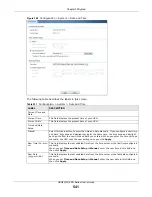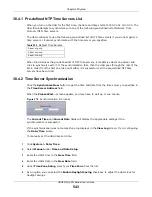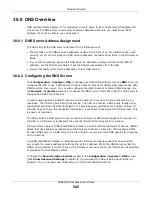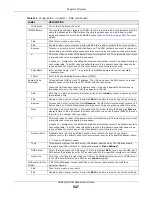
Chapter 30 System
USG20(W)-VPN Series User’s Guide
548
30.6.3 Address Record
An address record contains the mapping of a Fully-Qualified Domain Name (FQDN) to an IP
address. An FQDN consists of a host and domain name. For example, www.zyxel.com is a fully
qualified domain name, where “www” is the host, “zyxel” is the second-level domain, and “com” is
the top level domain. mail.myZyXEL.com.tw is also a FQDN, where “mail” is the host, “myZyXEL” is
the third-level domain, “com” is the second-level domain, and “tw” is the top level domain.
Remove
To remove an entry, select it and click
Remove
. The USG confirms you want to remove it
before doing so. Note that subsequent entries move up by one when you take this action.
#
This is the index number of the MX record.
Domain Name
This is the domain name where the mail is destined for.
IP/FQDN
This is the IP address or Fully-Qualified Domain Name (FQDN) of a mail server that
handles the mail for the domain specified in the field above.
Security Option
Control
Click
Show Advanced Settings
to display this part of the screen. There are two control
policies:
Default
and
Customize
.
Edit
Click either control policy and then click this button to change
allow
or
deny
actions for
Query Recursion
and
Additional Info from Cache
.
Priority
The
Customize
control policy is checked first and if an address object match is not
found, the
Default
control policy is checked.
Name
You may change the name of the
Customize
control policy.
Address
These are the object addresses used in the control policy. RFC1918 refers to private IP
address ranges. It can be modified in
Object > Address
.
Additional Info
from Cache
This displays if the USG is allowed or denied to cache Resource Records (RR) obtained
from previous DNS queries.
Query
Recursion
This displays if the USG is allowed or denied to forward DNS client requests to DNS
servers for resolution.
Service Control
This specifies from which computers and zones you can send DNS queries to the USG.
Add
Click this to create a new entry. Select an entry and click
Add
to create a new entry after
the selected entry.
Edit
Double-click an entry or select it and click
Edit
to be able to modify the entry’s settings.
Remove
To remove an entry, select it and click
Remove
. The USG confirms you want to remove it
before doing so. Note that subsequent entries move up by one when you take this action.
Move
To change an entry’s position in the numbered list, select the method and click
Move
to
display a field to type a number for where you want to put it and press [ENTER] to move
the rule to the number that you typed.
#
This the index number of the service control rule. The ordering of your rules is important
as rules are applied in sequence.
The entry with a hyphen (-) instead of a number is the USG’s (non-configurable) default
policy. The USG applies this to traffic that does not match any other configured rule. It is
not an editable rule. To apply other behavior, configure a rule that traffic will match so
the USG will not have to use the default policy.
Zone
This is the zone on the USG the user is allowed or denied to access.
Address
This is the object name of the IP address(es) with which the computer is allowed or
denied to send DNS queries.
Action
This displays whether the USG accepts DNS queries from the computer with the IP
address specified above through the specified zone (
Accept
) or discards them (
Deny
).
Table 234
Configuration > System > DNS (continued)
LABEL
DESCRIPTION
Содержание ZyWall USG20-VPN
Страница 17: ...17 PART I User s Guide ...
Страница 18: ...18 ...
Страница 99: ...99 PART II Technical Reference ...
Страница 100: ...100 ...
Страница 151: ...Chapter 9 Interfaces USG20 W VPN Series User s Guide 151 Configuration Network Interface Ethernet Edit External Type ...
Страница 152: ...Chapter 9 Interfaces USG20 W VPN Series User s Guide 152 Configuration Network Interface Ethernet Edit External Type ...
Страница 154: ...Chapter 9 Interfaces USG20 W VPN Series User s Guide 154 Configuration Network Interface Ethernet Edit Internal Type ...
Страница 155: ...Chapter 9 Interfaces USG20 W VPN Series User s Guide 155 Figure 121 Configuration Network Interface Ethernet Edit OPT ...
Страница 156: ...Chapter 9 Interfaces USG20 W VPN Series User s Guide 156 Configuration Network Interface Ethernet Edit OPT ...
Страница 170: ...Chapter 9 Interfaces USG20 W VPN Series User s Guide 170 Figure 127 Configuration Network Interface PPP Add ...
Страница 178: ...Chapter 9 Interfaces USG20 W VPN Series User s Guide 178 Figure 129 Configuration Network Interface Cellular Add Edit ...
Страница 194: ...Chapter 9 Interfaces USG20 W VPN Series User s Guide 194 Figure 139 Configuration Network Interface VLAN Add Edit ...
Страница 206: ...Chapter 9 Interfaces USG20 W VPN Series User s Guide 206 Figure 141 Configuration Network Interface Bridge Add Edit ...
Страница 282: ...Chapter 15 UPnP USG20 W VPN Series User s Guide 282 Figure 190 Network Connections My Network Places Properties Example ...
Страница 340: ...Chapter 21 IPSec VPN USG20 W VPN Series User s Guide 340 Figure 226 Configuration VPN IPSec VPN VPN Connection Edit IKE ...
Страница 348: ...Chapter 21 IPSec VPN USG20 W VPN Series User s Guide 348 Figure 228 Configuration VPN IPSec VPN VPN Gateway Add Edit ...
Страница 378: ...Chapter 22 SSL VPN USG20 W VPN Series User s Guide 378 Create a Web Application SSL Application Object ...
Страница 591: ...Chapter 31 Log and Report USG20 W VPN Series User s Guide 591 Figure 418 Configuration Log Report Email Daily Report ...
Страница 659: ...Appendix B Legal Information USG20 W VPN Series User s Guide 659 Environmental Product Declaration ...






























